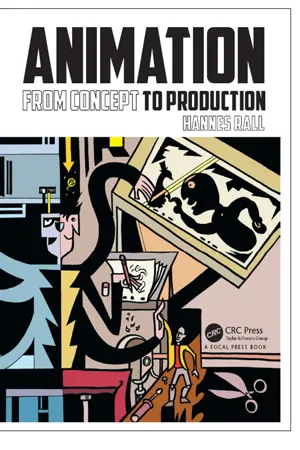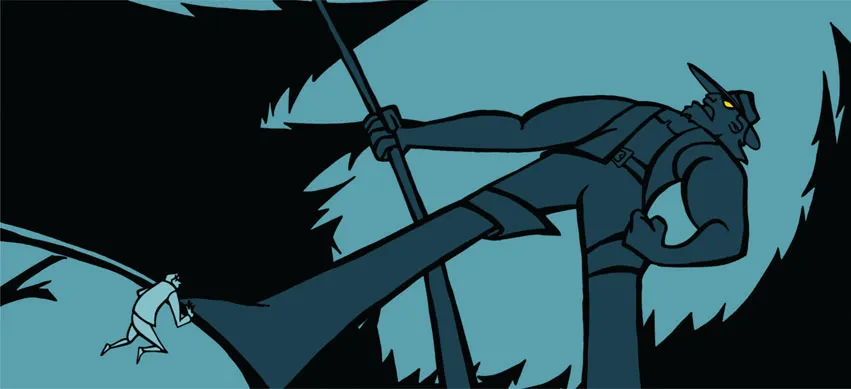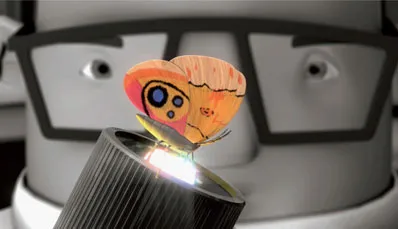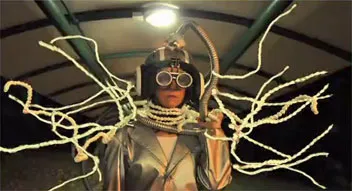![]()
Chapter 2.1
■
The Principles of Animation and their Application
This chapter provides an overview of the various animation techniques. It introduces the principles of animation, which can be applied to all techniques.
Film consists of single images (frames), which are played in rapid succession one after the other, creating the illusion of continuous motion for the viewer. In film, the world standard is 24 frames per second, but experiments with a frame rate of 48 frames per second are being conducted, in order to produce an even more life-like illusion of movement (“The Hobbit” trilogy, directed by Peter Jackson, 2012-2014). Animation refers to the art form that is produced by this cinematic illusion through the sequential exposure of single frames. In this process, the illusion for the animation of non-living objects is achieved through incremental changes of each single frame shot. The objects to be animated are usually “created” by the animator himself (or a team):This can be through drawings (traditional or digital), 2D animation, puppets or objects (stop motion), or digitally modeled characters (3D computer animation).
For the animator, it is both appealing and challenging to have absolute control over the look of each individual frame, as well as over rhythm and speed of the frame sequence, similar to a virtual puppeteer.
An animator has absolute control over every single image in the film, each frame.
In virtual 3D animation on the computer, each single frame is created as a modified version of the 3D model and can be played back immediately as a test.
Single frame exposure of each small change to the character for stop motion or puppet animation.
In traditional 2D animation, animation is done on paper in sequences, using a light box, and the successive drawings are then scanned and played back as a line test.
Some techniques:
For hand-drawn 2D animation (traditionally on paper or with digital tablet), incrementally modified drawings are sequentially shot. This technique offers the greatest artistic freedom for animation itself, since it does not impose limitations due to any physically or virtually defined object. These rest, however, in the drawing ability of the animator: Some tasks (such as perspective animation of an extremely detailed texture) exceed the capabilities of even the most talented animator.
Since traditional 2D animation was the dominant technology in mainstream animation until the onset of the digital age, the number of outstanding examples here is numerous, first and foremost in the area of mainstream, all Disney feature films, such as “Snow White and the Seven Dwarfs” (Hand, 1937) or “Sleeping Beauty” (Clark/Geronimi/Larson/Reithermann, 1959).In artistic short film, some outstanding examples are “Moonbird” by John and Faith Hubley (1959) and “Hill Farm” (1989) by Mark Baker.
Example for hand-drawn 2D animation from “The Cold Heart” by Hannes Rall
In stop motion, real objects (e.g., movable puppets) are animated, in other words, they are changed little by little by the animator and filmed with a camera after each change. The use of this technique, although identical in principle, can result in stylistically completely different films: The “Wallace & Gromit" films (Park, 1990-2008), are based on a comedic caricature approach and use puppets with a flexible rig. “Dimensions of Dialogue” (Švankmajer, 1982) uses clay animation to express visually disturbing political and philosophical allegories in experimental form.
Example from the student’s work “Dr.Avis' Dream” by Wang Rui Fan, School of Art, Design and Media, Nanyang Technological University, 2010: “Classic” stop motion, here puppet animation in a carefully and very detailed physically constructed set.
Cutout animation uses the same technique as stop motion, however, the animated objects are flat and are moved on a flat plane. This is possible both with real objects (similar to traditional stop motion) and with digital/virtual objects. Stop motion techniques often achieve a look that is more related to the drawn 2D animation, since it is graphical and “flat” in appearance. However, the conceptual approach resembles more traditional stop motion than 3D computer animation, regardless of the means of production. A well-known classic example is “The Adventures of Prince Achmed” (1926) by the German animation pioneer Lotte Reiniger.
One of today's masters of digital cutout animation is the Swiss animator Isabelle Favez (“Heart of Winter”, 2011).
Image from “Si Lunchai” (2013), Director: Hannes Rall, digital cutout, animation: Darren Lim, character design: Cheng Yu Chao. This film combines Lotte Reiniger’s tradition of silhouette film with influences of modernism and Southeast Asian shadow puppetry “Wayang Kulit”.
Construction scheme of a digital cut-out animation puppet from “Si Lunchai”, design: Cheng Yu Chao. A digital or physical cut-out animation puppet must be constructed with movable joints so that it can be changed to match the movements: The more complex and versatile these movements are, the more of these joints have to be inserted.
Hybrid forms between drawn animation, traditional painting, cut-out animation and stop motion:
■ Sand animation uses sand as a medium for animation, which is filmed on a glass plate lit from underneath. The freedom of manipulation in this medium makes this technique the most comparable to drawn animation. Ferenc Cakó from Hungary (“Ab Ovo”, 1987) and Caroline Leaf from Canada (“The Metamorphosis of Mr. Samsa”, 1977) are masters of this technique.
■ In a similar manner, plasticine on a light box can also be shot in various colors. However, this medium is more difficult to manipulate and therefore often uses a cross-dissolve technique and three- to six-frame animation. A master and pioneer of this technique is Ishu Patel from India/Canada. (“Afterlife”, 1978).
■ Animated painting is the animation of painting on glass, which is related to the above-mentioned techniques and an extremely difficult and elaborate technique, if you want to achieve a certain degree of realism. An outstanding artist in this style is Aleksandr Petrov (“The Old Man and the Sea”, 1999).
Painting and Drawing as a Process:
Other animators are less interested in the creation of an imaginary, yet credible world, but instead integrate the artificiality of their process as a conscious stylistic device by filming the incremental development of their large-format drawings or paintings during the development process. William Kentridge from South Africa (“Ubu Tells the Truth”, 1996-97) and Jochen Kuhn from Germany (“Neulich 1”, 1998) should be mentioned. They intentionally cross over into the field of “classical” fine art and exhibit their works also in the traditional settings of galleries.
In the case of 3D computer animation, a virtual puppet is usually created on the computer (= modeling), equipped with an animatable virtual skeleton (= rigging) and then animated like in the other techniques. Since the animator manipulates a virtual puppet step by step, this technique is actually more related to stop motion than drawn animation. All the more so, since, as a rule, his creative freedom is restricted by the limitations of his character, which are defined by modeling and, above all, rigging. The Pixar Studios, headed by John Lasseter, are inextricably linked to the rise of this technique as the world's dominating mainstream animation technology. Two of the most outstanding examples of this technique are “The Incredibles” (Bird, 2004) and the short film “The Lost Thing” (Ruhemann/Tan, 2010).
Example of a 3D computer animation: “Color Theory” (2011) by Davier Yoon, School of Art, Design and Media, Nanyang Technological University, Singapore.
Example of pixilation from “Big Bio” by Eileen Reynolds (2011).
Pixilation presents an exceptional situation, a special form of stop motion: Here, the actions of real actors are not simply filmed, but as in stop motion, single frame shots are manipulated. This creates interesting alienation effects (such as time lapse shots), resulting in a surreal and artistically appealing atmosphere. Pixilation also allows a simple form of visual effects, for example, by directly linking time separated images or omitting certain drawings of ...









